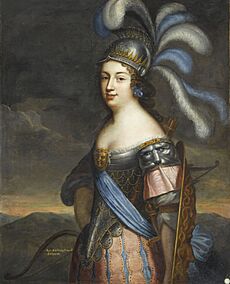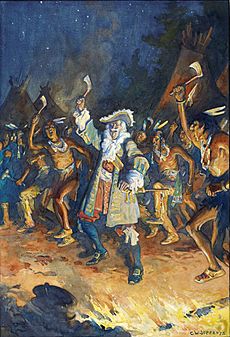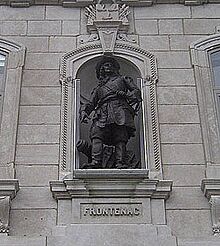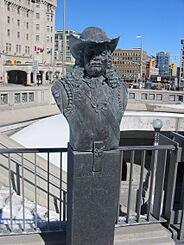Louis de Buade de Frontenac facts for kids
Quick facts for kids
Louis de Buade de Frontenac
|
|
|---|---|

Illustration of Frontenac
|
|
| 3rd and 6th Governor General of New France | |
| In office 1672–1682 |
|
| Monarch | Louis XIV |
| Deputy | none (1672–1675) Jacques Duchesneau de la Doussinière et d'Ambault (1675–1682) |
| Preceded by | Daniel de Rémy de Courcelle |
| Succeeded by | Joseph-Antoine Le Febvre de La Barre |
| In office 1689–1698 |
|
| Monarch | Louis XIV |
| Deputy | Jean Bochart de Champigny |
| Preceded by | Jacques-René de Brisay de Denonville, Marquis de Denonville |
| Succeeded by | Louis-Hector de Callière |
| Personal details | |
| Born | 22 May 1622 Saint-Germain-en-Laye, France |
| Died | 28 November 1698 (aged 76) Chateau St-Louis, Quebec City, New France |
| Signature | |
Louis de Buade, Comte de Frontenac et de Palluau (born May 22, 1622 – died November 28, 1698) was a French soldier and nobleman. He served as the Governor General of New France in North America. He held this important role twice: first from 1672 to 1682, and again from 1689 until his death in 1698.
During his time as governor, Frontenac built several forts around the Great Lakes. He also led many battles against the English colonists and the Iroquois people.
In his first term, he strongly supported expanding the fur trade. He even built Fort Frontenac in what is now Kingston, Ontario. However, he often disagreed with other leaders in the Sovereign Council. These disagreements were about the fur trade and the forced labor (called corvée) needed to build new forts. For example, he allowed the sale of brandy to Indigenous groups, which some, like Bishop François de Laval, strongly opposed. These conflicts eventually led to him being called back to France in 1682.
His second term was famous for defending Quebec from an English invasion during King William's War. He also led successful campaigns against the Iroquois and English settlements. These actions helped protect New France from the Iroquois threat. He also greatly expanded the fur trade with the help of Canadian coureurs des bois (forest runners). He died in New France before he could be called back to France a second time.
Contents
Early Life and Military Career
Louis de Buade de Frontenac was born in Saint-Germain-en-Laye, France, on May 22, 1622. His father, Henri de Buade, was a colonel in the army. Louis came from a respected family in France. His grandfather was a state advisor to King Henri IV.
Frontenac joined the army when he was very young, in 1635. He fought in Holland and Italy, showing great bravery and getting injured in battles. By 1643, he was a colonel. Three years later, he became a "maréchal de camp," a high military rank.
During the winter, when wars paused, Frontenac spent time at the King's court. This lifestyle was very expensive and led him to owe a lot of money. He even had to ask for special protection from the king to keep his properties from being taken by those he owed money to.
In October 1648, Frontenac married Anne de la Grange-Trianon. Their marriage was not a happy one. After their son was born, they separated. Frontenac then lived on his estate, where he continued to spend too much money and fell deeper into debt.
In 1669, France sent soldiers to help defend Crete against the Ottomans. Frontenac was chosen to lead these troops. He gained military fame there, but his financial problems continued. By 1664, he owed a huge amount of money.
In 1672, Frontenac was offered the job of governor-general of New France. This position helped him delay paying his debts until his term ended. He was appointed governor on April 6, 1672, and arrived in Quebec on September 7 of that year.
First Term as Governor of New France
When Frontenac became governor, New France was facing challenges. The previous governor and another important official, the intendant, had disagreed strongly. Frontenac was chosen to take over and bring stability.
From the start, Frontenac wanted to expand the colony and make it prosperous. He acted very independently, sometimes not following the wishes of the French minister, Colbert. As governor, Frontenac was the most powerful person in the colony. He was in charge of military matters and relations with Indigenous peoples. He was seen as the king's direct representative, meaning his authority was very high.
One of his first actions was to set up a colonial assembly, similar to France's Estates General. He wanted everyone to pledge loyalty to him as the king's representative. However, the king did not want to give too much political power to the colonists. So, measures were put in place to limit Frontenac's power. The Sovereign Council was given more authority, and the role of the intendant was brought back. Frontenac was very unhappy about this. He demanded that the council call him their "chief and president."
Frontenac was a strong-willed man who liked to be in charge. He soon got into arguments with the intendant, Jacques Duchesnau, and with church leaders. For many years, the church in New France was run by religious orders. But in 1674, François-Xavier de Montmorency-Laval became the first bishop of Quebec. Bishop Laval believed the church should have more power than the government.
Frontenac had allowed trading licenses that permitted the sale of alcohol. Bishop Laval, supported by the intendant, tried to stop this trade. They believed it was harmful to Indigenous peoples. The king and his minister in France had to deal with these ongoing disputes. Things got worse when Frontenac's follower insulted the intendant's son. Frontenac then physically assaulted the son and had him imprisoned. This was against the king's rules. After much discussion in France, both Frontenac and the intendant were called back to France in 1682.
Despite the conflicts, Frontenac's first term saw many improvements. Defenses were made stronger, and a fort was built at Cataraqui (now Kingston, Ontario). This fort was named Fort Frontenac after him. Peace was generally kept between the Iroquois and the French and their allies. Frontenac used this fort to trade with the Iroquois. He also used his position to increase his own wealth through the fur trade.
After Frontenac left, the Iroquois became more aggressive. His replacement, La Barre, was not able to handle them. The next governor, the Marquis de Denonville, also struggled. This led to the terrible Lachine massacre in 1689, where many French settlers were killed.
Second Term as Governor of New France
The colony was in a very difficult situation. King Louis XIV needed a strong leader to fix things. So, he chose Frontenac to return as governor. When Frontenac arrived in Quebec on October 17, 1689, he received a warm welcome. People felt hopeful again.
Frontenac's return during the Nine Years' War gave him a chance to show his military skills against England. He continued to benefit from the fur trade and still didn't like sharing power with the Sovereign Council.
In January 1690, Frontenac approved raids by French and Indigenous fighters against English settlements. These groups attacked towns like Schenectady and Salmon Falls. The raids were meant to stop the English from joining forces with the Iroquois. Instead, they united the English colonies against New France.
On October 16, 1690, English ships led by Sir William Phips arrived near Quebec. Phips demanded that Quebec surrender. Frontenac, brave and determined, famously replied: "No, I have no reply to make to your general other than from the mouths of my cannons and muskets." In the battle that followed, Frontenac's forces successfully pushed back the English. The English retreated quickly, leaving some of their cannons behind.
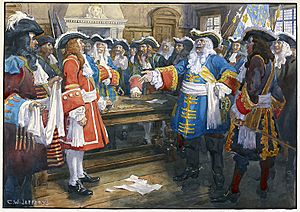
This victory increased Frontenac's reputation. He wanted to attack Boston by sea, but he didn't have enough resources. New France then had a short period of peace. During this time, Frontenac encouraged social life and even the return of plays at the Chateau St-Louis.
New France had been under attack for much of the 17th century. The people were resilient, and small battles continued for two years after Phips' attack. The colony suffered greatly. The fur trade, which was vital for survival, was cut off. Many furs were stuck in trading posts because the enemy blocked their path. To deal with this, Frontenac sent Jean Baptiste Bissot, Sieur de Vincennes to set up a trading post and fort at Kekionga (now Fort Wayne, Indiana).
At a large meeting with friendly Indigenous tribes, Frontenac showed his determination. He picked up a hatchet, waved it, and sang a war song, with his officers joining him. Christian Indigenous people from nearby missions, along with the Hurons and Algonquins, joined in. Frontenac even led a dance, whooping like the rest. His allies promised to fight until the end.
Several years of conflict followed. After three years of hardship, Frontenac managed to break the blockade of the Ottawa River. The valuable furs finally reached Montreal safely. The colonists cheered him as their "father and deliverer."
In 1696, even at 74 years old, Frontenac decided to lead an army against the Iroquois. On July 6, he left Lachine with a large force for the Onondaga village. When they arrived a month later, the Iroquois had left their villages. Since chasing them was not possible, the army began its return march on August 10. Frontenac handled the difficult march as well as the youngest soldier. For his bravery, he received the cross of St. Louis, a special honor.
Under Frontenac's leadership, all militiamen were given clothing and equipment. This included a coat, a breechcloth, leggings, a blanket, moccasins, a knife, and two shirts. This clothing was not a military uniform but typical Canadian civilian wear. Since these men were not paid, this was an affordable way to maintain a strong militia. The Canadian militia became very skilled at guerrilla warfare. They took the fight into Iroquois territory and attacked English settlements. After years of fighting, the Iroquois left the raided areas and made peace with the French. This finally ended the Iroquois threat to New France.
Frontenac died on November 28, 1698, at the Chateau St-Louis after a short illness. The Canadian people greatly missed him. While he could be difficult and liked to be in charge, he was also brave, clever, and decisive. He successfully overcame many challenges in a very important role.
Honours
Many places and landmarks are named to honor Louis de Buade de Frontenac. These include:
- Fort de Buade, in St. Ignace, Michigan, United States
- Le Château Frontenac, a famous hotel in Québec City, Québec, Canada
- Frontenac National Park in Québec, Canada.
- Avenue Frontenac, in Shawinigan, Quebec, Canada
- Rue Frontenac and Métro Frontenac, in Montréal, Québec, Canada
- Frontenac Street, in Sudbury, Ontario, Canada
- The provincial electoral district of Frontenac, Quebec.
- Frontenac County, Ontario, where Fort Frontenac was located
- Frontenac, Missouri, a suburb of St. Louis.
- Frontenac, Minnesota, an old resort town.
- Forward Operating Base Frontenac, in Afghanistan
- The Frontenac rose, a type of rose developed in Canada.
- The Kingston Frontenacs hockey team in the Ontario Hockey League
- Frontenac Squadron at the Royal Military College of Canada
- Frontenac School and Frontenac Park in Windsor Park, Winnipeg, Manitoba, Canada
- Frontenac Public School and Frontenac Park in Burlington, Ontario, Canada
- Frontenac Axis: A unique rock formation extending into the United States.
- Frontenac, Kansas, a city in Crawford County.
Folklore
Frontenac's family symbol is at the entrance to the Château Frontenac hotel. Part of the hotel stands where his old home used to be. Some people say they have seen his ghost, dressed in 17th-century clothes, walking through the halls or floating in the ballroom.


